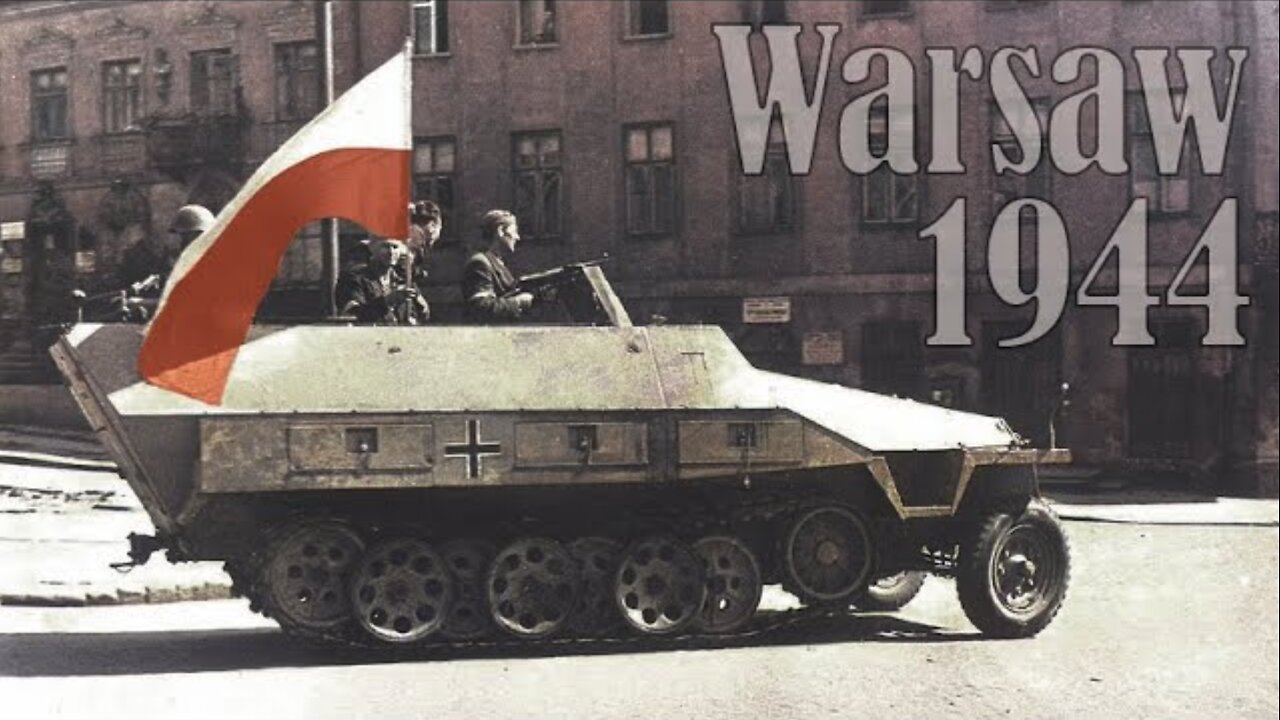Premium Only Content

WARSAW UPRISINGRAW Polish footage + German newsreel Europa Woche 86, Oct. 17, 1944
🔥PREVIEW ALL YOUTUBE VIDEOS
www.Patreon.com/Military1945
Episode 254
Be sure to give this video a THUMBS UP! Best way to support the channel!
SUBSCRIBE to M1945
ORIGINALS for sale...
https://www.militaria1945.com
Europa Woche Nr 86
17.10.1944
1:11 - Funeral for the deceased Lieutenant Colonel Helmut Lent
2:20 - Use of a special X-ray machine during operations
3:34 - Grape harvest in Croatia
4:15 - Market day in an Albanian town
5:13 - Ceramics school in Germany
5:58 - News group - HJ in action
7:08 - Youth road cycling race in Berlin
8:29 - Athletics competitions in Berlin
9:38 - Entry of General De Gaulle into Paris
10:39 - Surrender of the Polish troops in Warsaw
---
12:12 - BONUS: Raw footage from Polish resistance fighters taken during the Warsaw Uprising
WARSAW UPRISING
Background
Casualties during the Warsaw Uprising were catastrophic. Although the exact number of casualties is unknown, it is estimated that about 16,000 members of the Polish resistance were killed and about 6,000 badly wounded. In addition, between 150,000 and 200,000 Polish civilians died, mostly from mass executions. Jews being harboured by Poles were exposed by German house-to-house clearances and mass evictions of entire neighborhoods. The defeat of the Warsaw Uprising also further decimated urban areas of Poland.
Polish Home Army positions, outlined in red, on the western bank of the Vistula (4 August 1944)
In 1944, Poland had been occupied by Nazi Germany for almost five years. The Polish Home Army planned some form of rebellion against German forces. Germany was fighting a coalition of Allied powers, led by the Soviet Union, the United Kingdom and the United States. The initial plan of the Home Army was to link up with the invading forces of the Western Allies as they liberated Europe from the Nazis. However, when the Soviet Army began its offensive in 1943, it became clear that Poland would be liberated by it instead of the Western Allies.
In this country, we have one point from which every evil emanates. That point is Warsaw. If we didn't have Warsaw in the General Government, we wouldn't have four-fifths of the difficulties with which we must contend. – German Governor-General Hans Frank, Kraków, 14 December 1943
The Soviets and the Poles had a common enemy—Germany—but were working towards different post-war goals: the Home Army desired a pro-Western, capitalist Poland, but the Soviet leader Stalin intended to establish a pro-Soviet, socialist Poland. It became obvious that the advancing Soviet Red Army might not come to Poland as an ally but rather only as "the ally of an ally".
The Home Commander was, in his political thinking, pledged to the doctrine of two enemies, in accordance with which both Germany and Russia were seen as Poland's traditional enemies, and it was expected that support for Poland, if any, would come from the West.
The Soviets and the Poles distrusted each other and Soviet partisans in Poland often clashed with a Polish resistance increasingly united under the Home Army's front. Stalin broke off Polish–Soviet relations on 25 April 1943 after the Germans revealed the Katyn massacre of Polish army officers, and Stalin refused to admit to ordering the killings and denounced the claims as German propaganda. Afterwards, Stalin created the Rudenko Commission, whose goal was to blame the Germans for the war crime at all costs. The Western alliance accepted Stalin's words as truth in order to keep the Anti-Nazi alliance intact. On 26 October, the Polish government-in-exile issued instructions to the effect that, if diplomatic relations with the Soviet Union were not resumed before the Soviet entry into Poland, Home Army forces were to remain underground pending further decisions.
However, the Home Army commander, Tadeusz Bór-Komorowski, took a different approach, and on 20 November, he outlined his own plan, which became known as Operation Tempest. On the approach of the Eastern Front, local units of the Home Army were to harass the German Wehrmacht in the rear and co-operate with incoming Soviet units as much as possible. Although doubts existed about the military necessity of a major uprising, planning continued. General Bór-Komorowski and his civilian advisor were authorized by the government in exile to proclaim a general uprising whenever they saw fit.
-
 10:57
10:57
Military1945
1 day agoHow the Ministry of Propaganda wanted Germany to be seen in 1934, Pt 3 - Dresden, Weimar & Nuremberg
212 -
 54:47
54:47
Steven Crowder
2 hours agoSharpening Spiritual Tools, Handling Infidelity & Manifesting Destiny | Tough Love with Guru Crowder
69.3K243 -
 LIVE
LIVE
The Big Mig™
6 hours agoGlobal Finance Forum From Bullion To Borders We Cover It All
2,062 watching -
 LIVE
LIVE
LFA TV
16 hours agoGUTTING THE GOVERNMENT! | LIVE FROM AMERICA 2.21.25 11AM
5,275 watching -
 LIVE
LIVE
Film Threat
15 hours agoTHE MONKEY + DAISY RIDELY IN CLEANER + TONS OF REVIEWS | Film Threat Livecast
67 watching -
 28:38
28:38
pewculture
2 hours agoThe Pew Culture Podcast #12 - Suicide Squad
8.21K1 -
 LIVE
LIVE
Caleb Hammer
1 hour agoIf Her Husband Sees This, It's Over. | Financial Audit
293 watching -
 LIVE
LIVE
Major League Fishing
1 day agoLIVE Tackle Warehouse Invitationals, Stop 1, Day 1
318 watching -
 DVR
DVR
Bannons War Room
3 days agoWarRoom Live
1.02M220 -
 2:03:31
2:03:31
Matt Kohrs
11 hours agoPAYDAY FRIDAY!!! || The MK Show
40.3K3